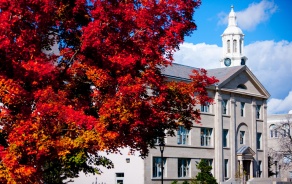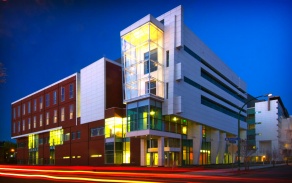About the University
Impactful research, scholarly distinction, transformative student experiences, and service to local, state, national, and international communities define UB’s mission as one of the nation’s leading public research universities.

Our History
UB was founded in 1846 as a private medical college located in downtown Buffalo and joined the State University of New York (SUNY) network in 1962. SUNY is the largest comprehensive university system in the United States, comprising 64 campuses with a total enrollment of approximately 424,000 students, and UB is the largest and most comprehensive public research university within the system. Over the years, UB’s scope and mission have expanded significantly as it has grown into a world-renowned research university that is the thriving heart of the regional community, a national leader in public higher education, and a global hub for excellence in research and education.
UB enrolls approximately 32,000 students (approximately two-thirds undergraduate and one-third graduate and professional students) and offers more than 400 degree programs at the baccalaureate, master’s, professional, and doctoral levels across 12 decanal units. The university enjoys a strong presence abroad, maintaining affiliation agreements with 80 universities in Asia, Europe, Latin America and Africa. Currently, UB’s more than 273,000 alumni live in 150 countries worldwide.
UB has a distinguished faculty of approximately 1,700 full-time and 750 part time members. UB is home to more than 100 research centers and institutes; its current annual research expenditures, including those in affiliated institutions, exceed $400 million.
Our Campuses
University at Buffalo students live and learn on three very different but complementary campuses: the North Campus, in a bustling, inner-ring suburb; the South Campus, in a historic urban neighborhood; and the Downtown Campus, in Buffalo’s dynamic medical corridor.

Our Academic Heart
UB’s North Campus, located just outside the city in Amherst, N.Y., is where most of the university’s core academic programs are offered. Opened in the early 1970s, it is the largest of our three campuses, encompassing cutting-edge academic and research spaces, student residence halls and apartments, award-winning dining facilities, the Student Union and athletic venues. Abundant green spaces, including a recreational lake and a 65-acre living woods, complement the built environment.

A Historic Gem
UB’s South Campus is a Western New York landmark dating back to the 1920s. Situated in a leafy residential neighborhood in North Buffalo, the 153-acre parcel is home to classic ivy-covered buildings and grassy, tree-filled quads along with high-rise residence halls and innovative research and teaching facilities. The schools of Architecture and Planning, Dental Medicine, Nursing, Pharmacy and Pharmaceutical Sciences, and Public Health and Health Professions are all located here.

Rising Biomedical Hub
The pillar of our Downtown Campus is the Jacobs School of Medicine and Biomedical Sciences, which moved there in 2017 following construction of a state-of-the-art building at Main and High streets. Most of our other Downtown Campus entities—including the New York State Center of Excellence in Bioinformatics and Life Sciences, the Clinical and Research Institute on Addictions, and the Clinical and Translational Research Center—are located near the Jacobs School in Buffalo’s medical corridor, a quickly growing hub of clinical care, research and education.